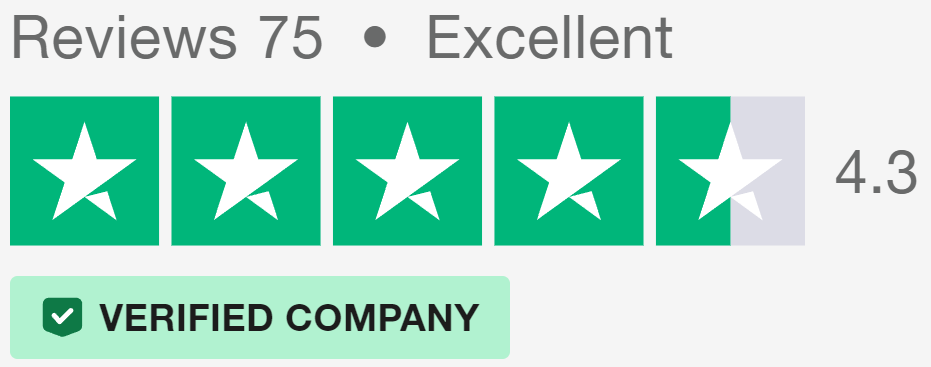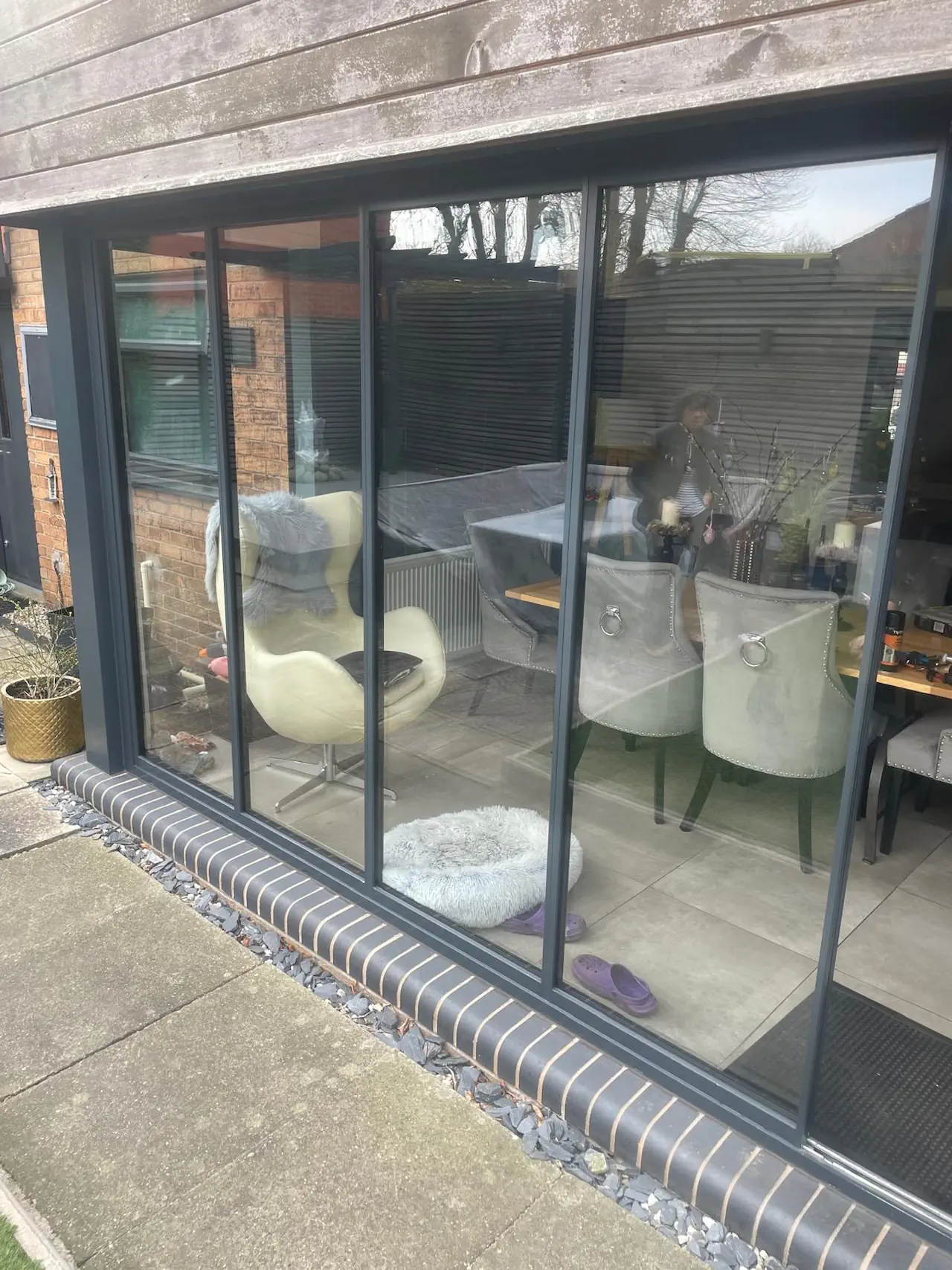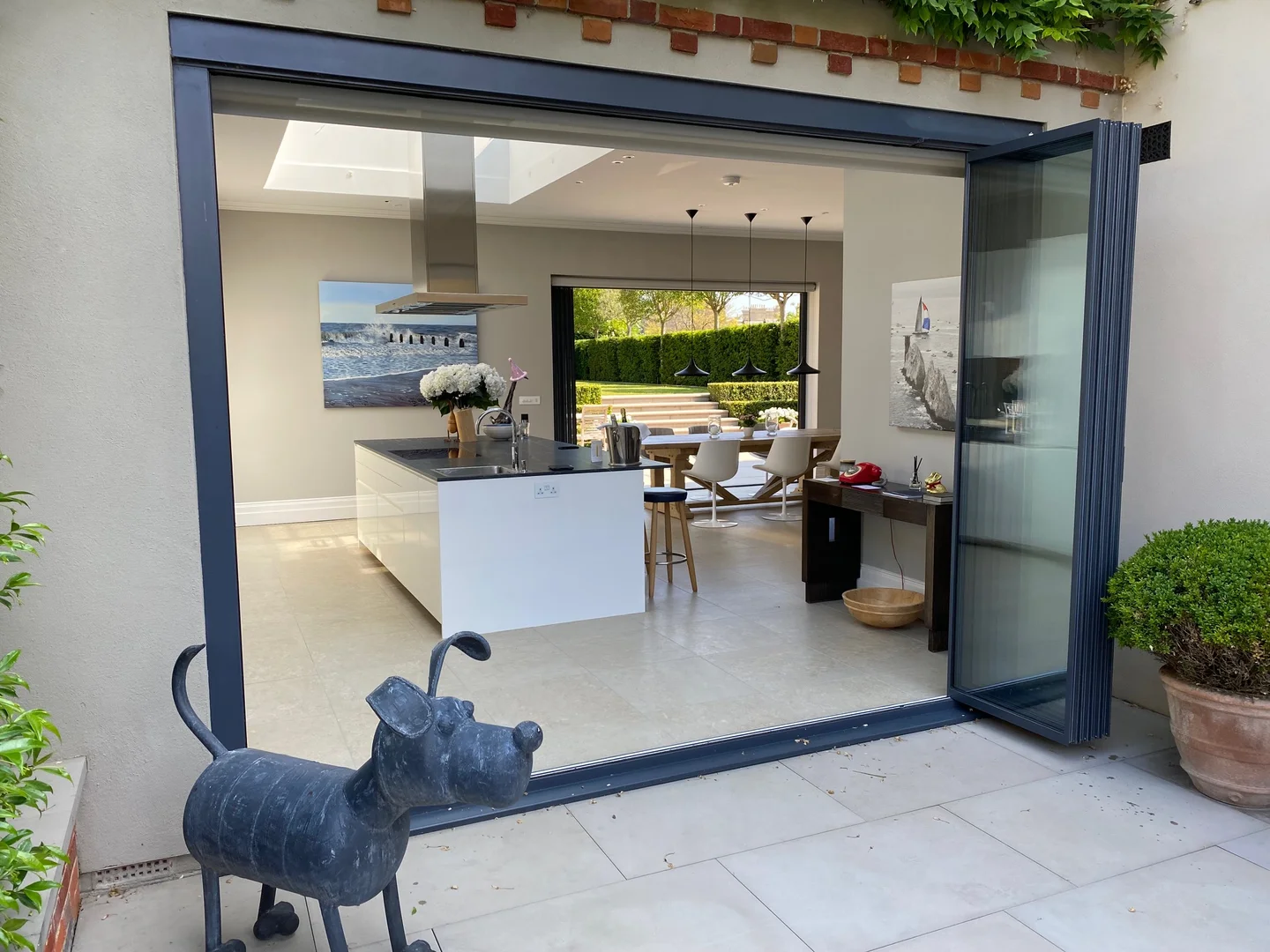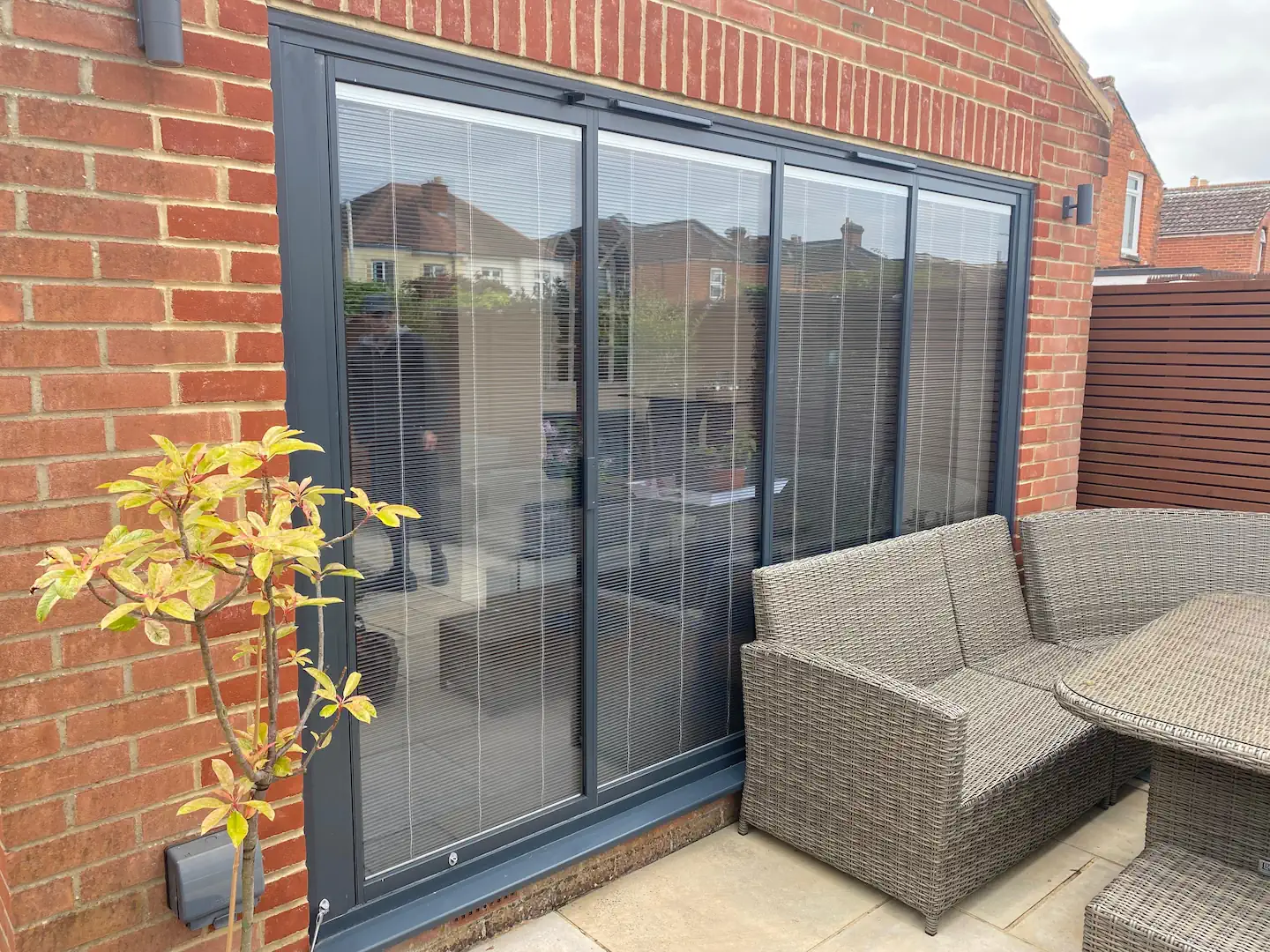Grey Bifold Doors: Style Tips & Design Ideas
Table of Contents

The Psychology of Grey Bifold Doors
Grey bifold doors bring subtle depth to modern British homes, balancing bold architectural features with understated sophistication.
Warm vs Cool Grey Shades
Choosing between warm and cool grey tones shapes how your space feels year-round. Warm greys, with their red and yellow undertones, make rooms feel welcoming and cosy even on cloudy days. Taupe-tinted grey bi fold doors pair beautifully with natural materials like timber and stone, creating an inviting atmosphere in open-plan spaces. Cool-toned grey bifolds featuring blue or green undertones work brilliantly in minimalist settings, lending a fresh, contemporary air to both traditional and modern homes.
How Light Changes Grey Tones
Morning sunlight draws out warmer notes in grey bifolding doors, while afternoon rays might emphasise cooler blue undertones. North-facing rooms need careful consideration – dark greys can feel heavy without adequate natural light. Rather than creating fixed lighting schemes, plan for shifting daylight patterns by testing samples at different times. Anthracite grey bifold doors remain a popular choice because their depth stays consistent throughout changing light conditions.

Grey in Modern Architecture
Raw concrete, exposed steel and sleek grey bifold doors form the backbone of contemporary British architecture. Bespoke bifold doors in mid-tone greys complement ultra-modern glass structures and period renovations alike, striking the right balance between statement and subtlety. Modern developments often feature grey folding doors as central design elements, using their clean lines to frame garden views while maintaining architectural cohesion.
Aluminium frames offer the slimmest sightlines for a refined look, while uPVC provides excellent value without compromising style. Each material exhibits grey finishes differently – powder-coated aluminium creates a smoother, more uniform appearance compared to the subtle variations found in grey uPVC systems. Frame material choice influences not just aesthetics but also the overall visual weight of your doors against surrounding walls and windows.
Grey Bifold Doors Finishes and Materials
Surface finishes and frame designs profoundly shape the visual impact of grey bifold doors in any space.
Matte vs Metallic Surfaces
Matte grey bifolds create a soft, sophisticated look that works particularly well in contemporary homes. Their non-reflective surface reduces glare and helps mask fingerprints, making them practical for busy family spaces. Metallic finishes add subtle shimmer and movement, catching light differently throughout the day. Powder coated aluminium doors offer excellent durability while maintaining their lustre, resisting scratches and fading far better than painted surfaces.
Raw metal finishes bring industrial charm to grey bi fold doors, though they require specific maintenance to prevent oxidation. Some homeowners opt for textured surfaces that mimic natural materials – these finishes add visual interest while maintaining the clean lines of grey bifolding doors.
Frame Thickness and Style
Slim frames dominate modern door design, with narrow bifold doors becoming increasingly sought-after. Wider frames project stability and substance, while thinner profiles suit minimalist design preferences. Frame thickness alters the proportion of glass to frame – slimmer frames allow more natural light and provide wider views, while chunkier options create stronger visual statements.
Grey frames need careful balancing with your chosen glass specification. Thicker frames cope better with triple glazing, though they might appear heavy in smaller openings. The frame’s visual weight should match your home’s architectural style – Georgian properties often suit substantial frames, while modern builds benefit from slender profiles.
Load-bearing requirements influence frame choices more than many realise.
Hardware and Handle Options
Handle designs range from minimal flush-mounted options to statement pieces in contrasting metals. Brushed steel hardware provides lasting durability without competing with grey door frames, while matt black creates striking contrast. Chrome fittings add modern polish but show fingerprints more readily than darker finishes.
Magnetic door catches improve usability while remaining hidden from view. Multipoint locking systems integrate discreetly into the frame design, maintaining clean lines without sacrificing security. Some systems feature intermediate handles that fold flat against the frame when not in use, preserving the doors’ sleek profile.
Styling Grey Bifold Doors in Your Home
Finding the right colour combinations and design elements helps grey bifold doors become natural focal points in any room.
Monochromatic Design Approaches
Layering multiple greys creates sophisticated depth without overwhelming the eye. Deep charcoal curtains against lighter grey bifold doors add visual interest while maintaining a cohesive look. Paint surrounding walls in paler grey tones to draw attention to the doors’ clean lines – this technique works especially well in modern spaces where simplicity matters most.
Mixing textures prevents monochromatic schemes from feeling flat. Soft grey fabrics and polished concrete floors complement structured grey bi fold doors, creating subtle contrasts through surface variation rather than colour changes. Large bifold doors particularly benefit from this approach, as their substantial glass area naturally introduces additional tonal variation.

Contrasting Colour Combinations
Strong accent colours make grey bifold doors stand out. Deep navy walls create great backdrops, while mustard yellow accessories pop against cooler grey tones. Forest green plants placed near grey bifold doors soften industrial materials and add natural vibrancy to the space.
Dual colour options allow for different shades inside and out. While maintaining a consistent shade of grey externally keeps your home’s facade unified, interior frame colours can match your indoor colour scheme. This flexibility helps grey bifold doors work harder in your overall design plan.
Floor and Wall Pairings
Pale oak flooring lightens spaces with dark grey bifold doors, preventing them from dominating smaller rooms. Herringbone patterns draw the eye toward garden views, while straight planks create clean sight lines that mirror door frames. Natural stone tiles in warm greys complement bi-fold doors while adding subtle pattern variation.
Wall treatments need careful planning around grey bifold doors. Textured wallpapers risk competing with door frames for attention, while flat paint finishes allow architectural details to shine. Feature walls work best on adjacent rather than opposing surfaces, creating balance without overwhelming the space.
Patterns
Geometric patterns echo the strong lines of grey bifold doors without overpowering them. Small-scale prints on soft furnishings add interest while allowing doors to remain prominent features. Bold patterns work best when kept to single elements – a striking rug or statement chair can anchor a space without creating visual chaos.
Material Mix
Raw timber brings warmth to spaces with grey bifold doors, preventing sleek surfaces from feeling cold. Exposed brick walls in traditional properties contrast beautifully with modern grey bifold doors, bridging old and new elements. Polished concrete offers industrial edge while reflecting light back into the room.
Metal accents in lighting fixtures and furniture should coordinate with door hardware finishes. Copper and brass add warmth to cool grey schemes, while chrome and stainless steel maintain modern minimalism. Mixing metallic finishes requires restraint – limiting choices to two complementary tones keeps spaces feeling intentional rather than cluttered.
Popular Colours for Grey Bifold Doors

Anthracite Grey Systems
RAL 7016 Anthracite has become a defining shade in contemporary architecture. This deep, rich tone makes grey bifold doors appear solid and grounded while maintaining a softer edge than pure black. Morning light reveals subtle blue undertones, while evening sun brings out warmer notes. Anthracite works exceptionally well on larger door installations where lighter greys might appear washed out.
North-facing rooms need careful thought before installing dark grey bifold doors – strong artificial lighting might be needed during winter months. South-facing spaces allow anthracite’s depth to shine, especially when sunlight plays across the surface throughout the day. While some worry about dark colours making spaces feel smaller, well-placed anthracite grey bi folding doors actually draw the eye outward, making rooms feel larger.
Slate Grey Options
Mid-range slate greys offer remarkable adaptability across different settings. Grey bifold doors in these medium tones hide dirt and fingerprints better than either very light or very dark options. Slate’s balanced undertones prevent it from leaning too warm or cool, helping it coordinate with existing windows and architectural features.
Natural slate varies in colour, and door finishes mirror this variation. Some manufacturers offer slightly different grades of slate grey within their ranges, allowing precise matching to other building elements. These subtle variations in grey bifold doors become more apparent as light changes throughout the day.
Light Grey Choices
Paler greys create bright, airy impressions without the stark contrast of white frames. These lighter tones particularly suit period properties where strong modern colours might jar with traditional features. Light grey bifold doors reflect more sunlight into interior spaces, brightening rooms naturally.
Pearl grey and silver grey finishes add metallic shimmer without appearing overly reflective. These pale options work beautifully in coastal homes where strong sunlight could make darker finishes feel heavy. Light grey tones also show less wear over time, though they may require more frequent cleaning to maintain their fresh appearance.
Seasonal Changes
Different seasons bring out varying qualities in grey bi fold doors. Summer sunshine highlights metallic undertones in lighter finishes, while winter light emphasises darker tones’ depth. Spring and autumn’s changing light creates subtle shifts in how greys appear, something worth remembering when selecting samples.
Special Finish Options
Textured finishes add another dimension to grey tones. Metallic flecks caught in sunlight create movement across door surfaces, while matt finishes absorb light for a more solid appearance. Some manufacturers offer slightly textured surfaces that hide minor scratches and dents better than smooth finishes.
Modern powder-coating techniques allow for incredibly precise colour matching. This matters particularly when installing grey bifold doors alongside existing windows or architectural features. Custom colour mixing services can create exact matches to heritage paint colours or specific design schemes, though these special orders typically involve longer lead times.
Paint technology continues advancing, with new formulations offering improved UV resistance and colour stability. Self-cleaning coatings reduce maintenance requirements, while anti-graffiti treatments protect ground-floor installations. These protective layers don’t change the colour’s appearance but add valuable durability to the finish.
Grey Bifold Doors Beyond the Garden
Traditional patio door installations represent just one way to use these versatile systems in modern British homes.
Internal Room Dividers
Grey bifold doors excel at creating flexible internal spaces that adapt to changing needs. Open-plan living areas benefit from temporary partitions that maintain visual flow while offering acoustic separation when needed. Pearl grey finishes reflect light through divided spaces, while darker anthracite frames create stronger visual breaks between zones.
Home offices tucked behind grey bifolds offer privacy without permanence. These temporary walls prove particularly valuable in properties where working patterns change regularly. When closed, solid panels with glazed top sections balance privacy with natural light distribution, while full-height glass maintains visual connections between spaces.
Kitchen zones separated by grey bi fold doors allow cooking odours to be contained without cutting off the chef from family life. Toughened glass panels resist heat and moisture while maintaining sight lines, and specialised coatings prevent fingerprints showing on frequently touched surfaces.
Matching Windows
Grey bifold doors need careful coordination with existing or new windows. Leading manufacturers now produce window systems specifically designed to match their door ranges in colour and profile depth. This matching extends beyond simple colour coordination – similar sightlines and frame proportions create visual harmony across entire facades.
Timber windows in period properties can be painted to match aluminium grey bifolds, though slight texture differences remain visible. Modern composite windows bridge this gap, offering traditional appearances with contemporary performance. Some homeowners deliberately mix frame materials, using grey bifold doors as statement features against more traditional window styles.
Frame Proportions
Slim window frames paired with chunky door sections create jarring visual contrasts. Professional designers often recommend matching frame face-widths where possible, helping external elevations appear more coherent. When exact matches prove impossible, choosing related proportions helps maintain visual balance.
Industrial Style Settings
Raw materials and exposed structures pair naturally with grey bifold doors in warehouse conversions and modern industrial-inspired homes. Polished concrete floors flowing under dark frames create strong architectural statements, while exposed brick walls add warmth and texture to minimal grey schemes.
Metal staircases and mezzanine levels complement grey bifolds particularly well. These architectural features share similar material qualities and visual weight, creating cohesive interior schemes. Factory-style windows installed above door systems echo industrial heritage while flooding spaces with natural light.
Original industrial buildings converted into modern homes often feature grey bifolds as replacements for old loading bay doors. These installations respect buildings’ commercial heritage while improving thermal performance and usability. Retained industrial elements like exposed beams and columns create authentic backdrops for contemporary door systems.
Creative Applications
Innovative architects increasingly specify grey bifolds as movable walls in commercial-to-residential conversions. These installations often incorporate partial glazing or solid panels, providing privacy where needed while maintaining the doors’ space-dividing capabilities. Corner installations that open fully create diagonal views through buildings, while curved tracks allow doors to follow organic building forms.
We’d Love to Help You
Vision Glass Doors is a designer, manufacturer, and installer of premium door systems. We are a family run business with over 20 years’ experience and 5,000 installations across the UK.
Our leading range of door systems include Ultra Slim – Slide and Turn Doors, Slimline Sliding Patio Doors and Frameless Glass Doors. Suitable for various internal and external applications, they are applicable to residential and commercial projects.
Click Quick Quote Online for a free quotation within 24 hours. Alternatively, call or email us on 01582 492730 or at info@visionglassdoors.co.uk.

